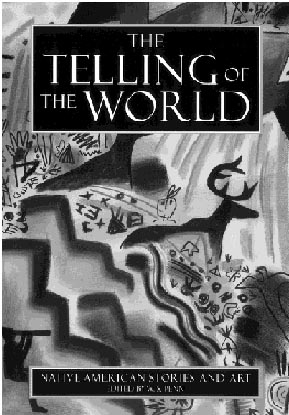 Tales of Creation and Beyond
Tales of Creation and Beyond
by Gayle Ross
In 1989, I sat in my cousin's living room talking with Hickory Starr, the principal chief of the Redbird Smith Nighthawk Keetoowah Stomp Dance Ground. We were taking a break from a weekend of activities commemorating the 150th anniversary of the end of The Trail of Tears. I had just told a Cherokee story at the tribal museum about Possum and Turtle, and Hickory was saying in his quiet way that he believed that the rhythmic syllables of the stomp dance songs might be the ancient language once spoken by all the creatures living in the beginning days of the world. I looked at him and for the briefest of moments, his eyes met mine. "It's good you tell those old stories," he said. "If the earth does not hear the creation story, she might forget to create herself." Hickory passed to the Nightland several years ago, but his memory and his words are with me still.
In The Telling of the World, a breathtakingly beautiful anthology by Nez Perce/Osage writer and editor W. S. Penn, the vibrant world of traditional and contemporary Native American storytelling lives in print. Gathering stories from over 40 tribes from the Alabama to the Zuni, and grouping them according to seven themes, Penn leads the reader on a rich and satisfying journey from the days of creation through the stages of human experience, culminating in death and the possible worlds beyond.
Significantly, Penn has included both traditional stories told in a familiar narrative style as well as the works of current Indian writers, some of whom fashion an ancient story into narrative poetry and contemporary fiction. Four of Penn's own stories are included here, my favorite being "Albert Hummingbird Meets Death," in which an old man has a roadside encounter with Death, who is decked out in turquoise and drives a conversion van. It is a wickedly funny piece, as is Peter Blue Cloud's "Coyote's Anthro," the story of a modern anthropologist's nighttime visit from Coyote, who is just trying to help him see a little better what he is looking at. All too often, non-Indian people tend to see Native American culture only in terms of the past, and by including such gifted Indian writers and storytellers as Peter Blue Cloud, Lee Francis, Simon Ortiz, Jenny Leading Cloud, Leonard Crow Dog and others, Penn demonstrates ably that Native American storytelling, like Indian culture itself, is alive and well. Living and breathing, growing and changing, it is very much a part of our modern world.
Also significant is the fact that, for the most part, the voices heard here are Indian voices. The few non-Indian writers, such as Richard Erdoes and Jarold Ramsey, have spent so many years in the Indian community that they can speak well from within the culture.
Many stories which were collected at the turn of the century have been retranslated and reevaluated in terms of the original languages and story structures. In his preface, Penn describes the painstaking work of the new translators and transcribers who check and recheck their translations with Native tellers. In this way, many of these old stories speak with a truer voice, without the inevitable Eurocentric bias which seems to permeate the writings of even the best-hearted 19th-century ethnologist or folklorist. The book also includes many wonderful Indian stories that are all too often left out of anthologies because of subject matter which may be deemed inappropriate in the larger society but is dealt with frankly and matter-of-factly in Indian culture. Like sex. Right next to the hauntingly beautiful Lakota story of the courtship flute, you will find the hilarious Ponca-Otoe story of "Teeth in the Wrong Places." You need both to see the whole picture.
As Penn notes in his preface, The Telling of the World is really two books living comfortably within the same cover. Just as the stories demonstrate the rich diversity found in Native America, the art chosen to illustrate them conveys the same message. The paintings and photographs of carvings and masks provide a feast for the eyes in the same way the stories do for the mind and heart. One might choose to purchase this book as a story collection or an art book, but either way, it will be a good choice.
Penn tells the reader that he refused to use the word "myth" in the title of this book because of the connotations attached to that word. I too deplore the fact that the word "myth" has become, in modern usage, a synonym for "lie." To me, it is the height of arrogance for people to assume that the set of spiritual stories they hold sacred are the "true" ones and all others are superstition. The very sacredness of story lies in the ability to create worlds, "real" and "unreal," "seen" and "unseen." As a very wise person once said, "All stories are true, even the ones that never happened."
Gayle Ross is a Cherokee storyteller and writer. She
was a featured speaker in the 1996 Fall Festival of Children's Books at
the Carnegie Library of Pittsburgh.